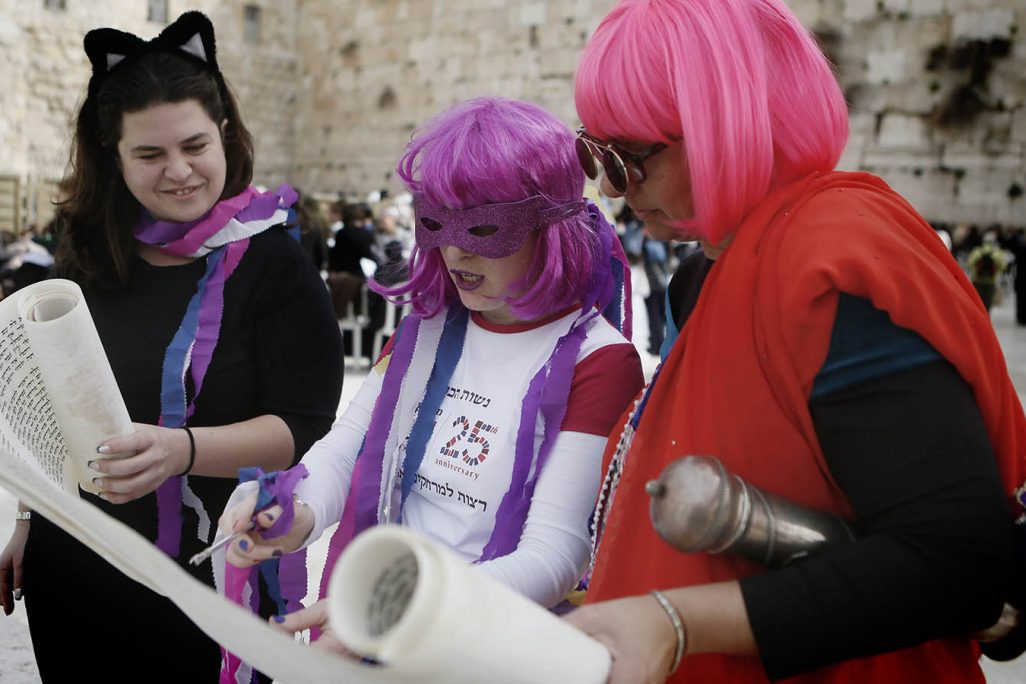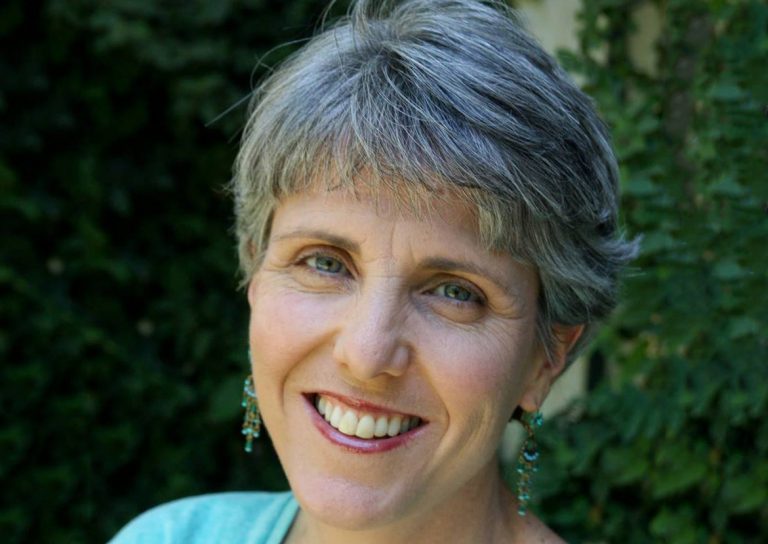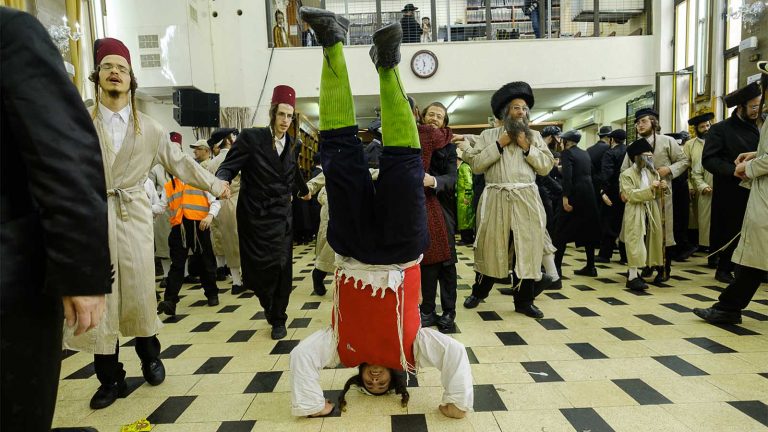
The holiday of Purim, which Jews in Israel and around the world celebrated earlier this month, is seen as a time of joy, laughter, and levity. The Book of Esther, though, which recounts the story of the holiday, is more complex than the holiday itself might suggest.
One of the nuances raised by the Book of Esther is the questions of the role of women in the story. Davar spoke with Dr. Hannah Pinhasi of the Hartman Institute about feminist readings of The Book of Esther.
According to Pinhasi, early Jewish American feminists saw Vashti, the queen of Persia who refused to dance at the king’s banquet, as a role model. In response to her refusal to dance, Vashti loses her status as queen — and, accordingly to some commentators, her life. In the biblical text, the king’s advisors insisted that he respond to the queen’s disobedience because her decision was influencing women to no longer obey their husbands.
But Vashti is not the only woman in the Book of Esther who can be a role model for female liberation. “We don’t want to identify only with Vashti,” Pinhasi says. “In our identity as Jews, our primary identification is with Esther. And the question is how to re-read Esther. In the last 20, 30 years, there have been new readings in the image of Esther.”

Esther enters the story after Vashti’s expulsion. She is meant to be a young and submissive replacement for the previous queen. King Achashverosh commands his men to go through his entire kingdom and take every good-looking virgin from her home and family. All the virgins are brought to Achashverosh harem. Esther, a Jewish orphan under the care of her uncle Moderchai, is one of those young women. Somehow, after a year of preparation and training, she manages to reach the finals of "Survivor: Harem” and win the royal crown. By the end of the story, she saves all the Jews in the kingdom from the threat of genocide.
“Esther becomes a leader,” Pinhasi says. “She starts as a woman who is taken away, a woman who is chosen because she is different from Vashti, because she is silent and does what is commanded of her.
“When Mordechai tells her to go make a request to the king [to prevent the killing of the Jews], she tells [Mordechai], ‘Go gather all the Jews,’ and only after Mordechai does as she says, she goes to the king. She understands that we need solidarity, that we must first be together."
Pinhasi describes a process in which Mordechai's obedient protégé begins to say for herself what she thinks should happen. "The power to understand that she has a leadership role was born in Esther,” Pinhasi says.
“In this sense, Esther is like each and every one of us who grew up in a society that we call liberal and Western, which is still a society that basically forces a lot of things on us. It is necessary for us to become women who undermine this structure,” she says. In Pinhasi’s reading then, Esther’s ability to change and cope with a difficult reality sets her up as a role model.
Sexuality in the Book of Esther
The women in the Book of Esther also reveal different aspects of female sexuality. Esther was chosen for her new role primarily because she is a good-looking virgin. She goes through a year of cultivation and training and “succeeds” to use her power as a good-looking young woman to reach the status of queen. Not only that, her uncle uses Esther's status as a way to find his place in the king's court.
Pinhasi calls attention to the complicated message that the story conveys to girls, who are already exposed to conflicting messages on the subject of female sexuality. She references a popular sketch from the popular Israeli satire show “The Jews Are Coming,” in which Esther, upon hearing Moredchai’s plan for her to save the Jews, responds, “So you want me to be a whore.”
“I talk to principals and teachers, the entire educational staff, and they feel embarrassed by the sexuality that erupts on Purim, which is not exactly age-appropriate,” Pinhasi says. “Teachers tell us that young girls feel that this is the thing that will give them strength. They don’t fully understand what this sexuality is transmitting, but they understand that our society is telling us that ‘you will have much more power, immediately, through your sexuality.’”
אם פרסומות לתחפושות היו הפוכות***יצרתי את התמונה הזאת לא כדי לצקצק על "הנערות של ימינו" שמתדרדרות ולובשות תחפושות…
Posted by פוליטיקלי קוראת on Tuesday, March 15, 2016
“Our question,” Pinhasi says, “is what can we actually do to show them the Esther who is an emerging leader. And that is a long educational project."
Pinhasi imagines such an educational project consisting of many aspects, including the types of costumes worn on the holiday.
“How can you be a doctor and not a sexy doctor? How do you offer costumes that relate to you as a person and not just as a sexual creature? First of all, we need to raise awareness of this, and teach Esther as a more complex character,” she says.
The question of costumes is complicated by the fact that Purim is a day in which things are meant to be turned upside down — what is generally forbidden is suddenly allowed. According to traditional Jewish thought, Pinhasi says, “It’s not that if you undress you're more authentic and if you dress up you're artificial. After all, Purim is also a carnival that allows us to reveal or search for or express other parts of ourselves that are actually empowering those elements that already exist in our lives.”
“The forces that are saying ‘modesty, modesty, modesty,’ and the forces that say, in a masculine voice, ‘be free’ and mean ‘naked’ … are two forces that have the same thing within them. And our ability to recognize this delicate place that gives us power takes a long way," Pinhasi says.
"The question of how an educational space produces this thing is not a simple challenge. The first stage is managing to put a question mark over this whole thing. Within all this, it is worthwhile to allow some new reading of Queen Esther as a way to talk about it openly."

Pinhasi pointed to the Fast of Esther, the customary fast commemorating Esther’s efforts to save the Jews, as a custom potentially ripe for reclaiming.
“Perhaps it is worth reiterating the Fast of Esther and mentioning together with her all the women who are imprisoned in all kinds of places that they cannot get out of,” she says. “She was in a cage of gold, but there are women who are trapped in all kinds of places. There are organizations that struggle to [help Jewish women who are denied a divorce by their husbands] and mention Taanit Esther, but this can be expanded.”
“Women today are in a similar position to Esther,” Pinhasi says. “Our femininity is on uncertain ground. Esther is an example of a woman who took these constraints and managed to turn them into a mission.
"I feel that when I stand in my synagogue and read the Book of Esther, I am doing a subversive act," she says. "I do what Jews do to express, to celebrate this holiday, and in that sense I give a different voice to Esther and put her in a new context.”
This article was translated from Hebrew by Leah Schwartz. It was originally published in Hebrew in March 2019.






